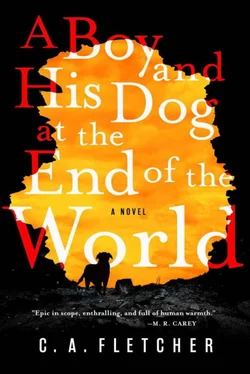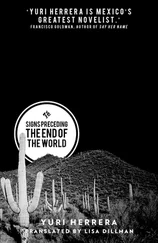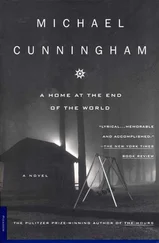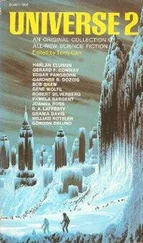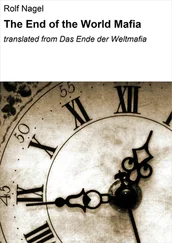C Fletcher - A Boy and His Dog at the End of the World
Здесь есть возможность читать онлайн «C Fletcher - A Boy and His Dog at the End of the World» весь текст электронной книги совершенно бесплатно (целиком полную версию без сокращений). В некоторых случаях можно слушать аудио, скачать через торрент в формате fb2 и присутствует краткое содержание. Город: New York, Год выпуска: 2019, ISBN: 2019, Издательство: Orbit, Жанр: sf_postapocalyptic, на английском языке. Описание произведения, (предисловие) а так же отзывы посетителей доступны на портале библиотеки ЛибКат.
- Название:A Boy and His Dog at the End of the World
- Автор:
- Издательство:Orbit
- Жанр:
- Год:2019
- Город:New York
- ISBN:978-0-316-44945-8
- Рейтинг книги:5 / 5. Голосов: 1
-
Избранное:Добавить в избранное
- Отзывы:
-
Ваша оценка:
- 100
- 1
- 2
- 3
- 4
- 5
A Boy and His Dog at the End of the World: краткое содержание, описание и аннотация
Предлагаем к чтению аннотацию, описание, краткое содержание или предисловие (зависит от того, что написал сам автор книги «A Boy and His Dog at the End of the World»). Если вы не нашли необходимую информацию о книге — напишите в комментариях, мы постараемся отыскать её.
A Boy and His Dog at the End of the World — читать онлайн бесплатно полную книгу (весь текст) целиком
Ниже представлен текст книги, разбитый по страницам. Система сохранения места последней прочитанной страницы, позволяет с удобством читать онлайн бесплатно книгу «A Boy and His Dog at the End of the World», без необходимости каждый раз заново искать на чём Вы остановились. Поставьте закладку, и сможете в любой момент перейти на страницу, на которой закончили чтение.
Интервал:
Закладка:
I returned to the church and very carefully backed up to its thick wooden door, pressing the tip of the knife into the grain as hard as I could. Then I carefully put my wrists on either side of the blade and began to saw.
The knife fell out twice and I had to awkwardly pick it up and stick it back in before I got my hands free. And when they were my own again I gave a yelp and ran to the top of the slope that crested the island to check on the Sweethope .
It was gone.
He hadn’t taken it in tow, because I could see his red sails in the distance, but he must have cut the anchors loose. Maybe in retaliation for my locking up his anchor chain. I saw the Sweethope closer in, but still too far to swim for. And it was moving away on the drift of the tide.
My heart began to hammer again, but I was not too worried as I ran back down the slope to the other side of the island where the kayak was. I could move fast when I paddled, faster than the tide, and though it would be a long pull I knew I could reach the boat.
And I had to. Not just because it was my boat. But because Jip was locked below. If the boat got away from me, he would slowly starve and die of thirst. Alone. And believing he had been forgotten.
That thought made me run faster, which was a mistake because I fell and twisted my ankle and then had to hobble the last hundred yards.
Brand had found my kayak. And he’d been annoyed by it. The paddle lay snapped on the shoreline, as if he’d thrown it in the water which had then floated the parts back to shore. He’d also stamped through the kayak, putting a foot-sized hole in the top covering about where my knees were.
I cursed and turned the kayak over to look at the hull. And then I breathed a deep sigh of relief. You could see where his foot had smashed the bottom of the boat against the rocks, but it had not made a hole.
My heart was thumping badly and my hands were trying to move too fast and I fumbled and dropped the bow as I slid it out of the kayak. I left it on the ground and retrieved the broken paddle. Again I was moving too fast and nearly sliced my thumb open as I cut the mooring rope that was coiled in the bottom of the boat and used it to start lashing my bow as a splint between the two broken parts. My fingers seemed to have forgotten how to tie the right knots as the anchor knot kept slipping loose and making the whole lashing come loose. I closed my eyes and made myself count twenty very slow elephants. Then I cinched the beginning of the lashing so tight it hurt my hands as I kept the tension on, and wrapped the bow into the paddle. I took extra care with the finishing knot, and then tested the repaired paddle. It felt clunky in my hands but solid.
I didn’t waste time looking back at that church; I just gritted my teeth, told myself I was fine and not hungry or thirsty or hurting in all the wrong places, and dug in.
I paddled around the point and scanned the sea ahead of me. No sign of the red sails, which was not such a bad thing, but also no sign of the Sweethope . Which was. I began to feel that rising panic again and looked around to get my bearings, trying to work out where I’d stood on the hillock that divided the island, and then remember the rough direction the boat had been drifting.
As I did so, I realised that one reason I maybe couldn’t see the Sweethope was that I had been looking from a higher angle on land, whereas now I was sitting at sea level. And then again the sails were down which made it harder still to spot.
It’s almost impossible to stand up in a kayak, but I did. Very, very carefully. And then I saw the mast, and then the hull, and then as I sat down I realised I could still see them both. It was as if the panic had blinded me. Like I thought I’d lost them, so I did lose them.
The wind was getting stronger and blowing with the tide, which I didn’t like. I fixed my eye on the Sweethope and began the chase into the choppier waters between the bigger island and the mainland beyond. I kept an eye on the hills in the far distance and made a point of keeping track of the direction the Sweethope was drifting by using them as markers. I decided if the gap between us lengthened because of wind or my arms tiring I should still be able to find the boat by keeping on its bearing.
When I made the plan, I felt it was one of the ones you make for luck but you’re never going to need. Maybe an hour later I seemed no closer and my arms were shaking and my shoulder sockets seemed to have grit in them.
Then a sudden squall blew in from over my shoulder and I took my eye off the boat to look at the hole in the kayak top, wondering if the rain would fill the hull. I decided maybe I should take off my sheepskin and stuff it down there to prevent water getting in, and then when I looked up I couldn’t see either the Sweethope or the mountains beyond.
I decided once more not to panic.
But I did want to.
Instead I closed my eyes and concentrated on feeling the kayak and the current.
If you paddle in open water, there’s always a tension between you, the sea and the boat. You want to go to A, the sea’s pulling you towards B and your body feels the tension between those two destinations with every stroke as it fights B and angles the kayak towards A. I’d been paddling hard for more than an hour, maybe two even, and without noticing it my body had got into a habit and a feeling. I concentrated on getting that tension back—recreating the pull of the water and the balancing pressure as I pushed the kayak where I wanted it to go.
I was literally paddling blind.
It was like a game I used to play on the big wide beaches on Uist: close your eyes and see how far you could walk before you opened them. On the hard-packed sand, it was a matter of counting steps and feeling the slope of the beach so you didn’t veer into the shallows. It was always easy to start with and then you began to wonder if there was some treacherous loop of seaweed or piece of drift-garbage that was going to trip you at your next step. Eventually, a kind of horizontal vertigo would grip me and I’d open my eyes to find the beach clear ahead and all the snares only in my mind.
I counted to a hundred, then another and then halfway to the next hundred I felt the rain stop and I opened my eyes and there was the Sweethope , almost dead ahead. I grinned and felt good. Then I realised it was much closer than I’d expected and felt even better. And then I heard a distant barking, and felt worse as my thinking brain caught up with my excitement.
The Sweethope was turning slowly, and the reason it was closer than I had expected was that it was caught on a skerry. Shallow banks of sharp-toothed rocks are common around the islands, lurking just below the water, ready to rip the bottom out of any boat too blind to see them. As the Sweethope continued to yaw around, it revealed a lick of white in the water behind it where one of the treacherous outcrops was just breaking the surface.
Fear surged through my shaking arms and gave a boost of energy I didn’t know was still in me. The barking got high-pitched and urgent as I approached, and that helped too.
When I was about a hundred yards out—and just beginning to think everything was going to be all right—there was a cracking noise and the boat slewed drunkenly in the opposite direction to the one it had been going. The current had twisted it off one rock and snagged it on the next one. I had visions of the scene inside the cabin if the hull were holed and that noise meant water was now gushing in, and I started shouting and whistling so that Jip would know help was on the way.
Brand had been in a hurry to get going, and so had only cut the anchor ropes in order to set my boat adrift. They were whipping the side of the hull in the freshening breeze, and I snapped my hand out and caught the flailing end of one and used it to pull myself alongside. I shouted to Jip and banged the boat and as his barks mounted in excitement I threw my paddle into the cockpit and awkwardly scrambled aboard, almost losing the kayak as I did so, and then as I sprawled to keep hold, I nearly fell back into the water myself.
Читать дальшеИнтервал:
Закладка:
Похожие книги на «A Boy and His Dog at the End of the World»
Представляем Вашему вниманию похожие книги на «A Boy and His Dog at the End of the World» списком для выбора. Мы отобрали схожую по названию и смыслу литературу в надежде предоставить читателям больше вариантов отыскать новые, интересные, ещё непрочитанные произведения.
Обсуждение, отзывы о книге «A Boy and His Dog at the End of the World» и просто собственные мнения читателей. Оставьте ваши комментарии, напишите, что Вы думаете о произведении, его смысле или главных героях. Укажите что конкретно понравилось, а что нет, и почему Вы так считаете.
